 |
 |
 |
 |
 |
 |
 |
 |
 |
| Ghettos |
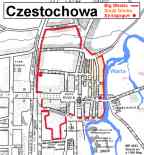 |
| Big Ghetto |
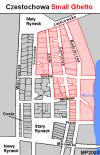 |
| Small Ghetto |
By June 1942 the ghetto’s population had increased to around 40-50,000; around 15,000 Jews from the surrounding area had been forced to move into the ghetto.
On 16 September 1939 the Judenrat was established, led by Leon Kopinski. Other members were three lawyers (J. Gitler, Z. Rotbart, S. Pohorille), the director of the Jewish Gymnasium (Anisfelt), a famous sportsman (B. Kurland), L. Bromberg and N. Berliner. On 4 October 1942 all members were deported to Treblinka (except Kopinski and Kurland), together with members of the Jewish ghetto police and their families. Kopinski was shot after the deportation, Kurland became chief of the Judenrat until 22 July 1943 when he was accused by the Germans of being disloyal. Finally he was shot at the Jewish cemetery.
 |
| Aerial Photo |
In August 1940 about 1,000 young men from Czestochowa between the ages of 18 and 25 were sent to the Forced Labour Camp Cieszanow (in the Lublin District). They were sent to build the highway; almost none survived. One of the survivors was Joseph Sher.
The ghetto remained "open" until 23 August 1941; then it was sealed off.
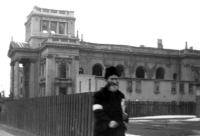 |
| Burned Synagogue in 1941 |
Nobody in the ghetto believed that deportations would occur. Everybody assumed that the ghetto was important for war production. Even when in July / August 1942 many Warsaw Jews escaped to Czestochowa and talked about deportations to the Treblinka death camp, the Jews of Czestochowa did not believe them. Horrible stories, told by Treblinka escapees, were called "the imagination of sick brains".
 |
| Deportation Square * |
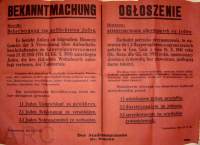 |
| Decree from 24 September 1942 |
The first Aktion was organized on Yom Kippur, 21 - 22 September 1942. In the night SS and Ukrainians from Trawniki surrounded the ghetto and installed lamps on the streets. Then the Jews were thrown out of their flats. They had to gather in front of the Metallurgia factory, where a selection took place. Around 7,000 Jews were forced to march to the railway ramp at Zawodzie. There they had to enter cattle wagons and were deported to Treblinka. 200 other people were killed on the spot, 350 selected for work. A mass grave for the murdered Jews was dug on Kawia Street.
The next "actions" were organized on 25 - 26 and 28 - 29 September. The selections took place on streets and courtyards. The Germans informed the members of the Judenrat that the Jews would be deported to work camps in Eastern Poland. Those who had been deported "are already working and happy". Through loudspeakers they told the remaining Jews that all deportees lived in good conditions in the camps and that each volunteer would get 1 kg bread, jam and a plate of soup. Therefore many people went to the deportation square voluntarily.
Another deportation took place on 4 October: Among those deported to Treblinka were members of the Judenrat and many Jewish policemen were deported to Treblinka. The last transport (7 October) stopped in the small town Koniecpol. Around 1,500 Jews from Koniecpol joined the train to Treblinka.
During the liquidation of the Big Ghetto approximately 40,000 Jews from Czestochowa were deported to Treblinka. Every death train consisted of 60 cattle wagons, each occupied by around 130 persons. About 2,000 people were murdered in the ghetto, including tenants of old people's homes and children from orphanages.
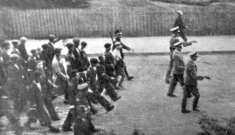 |
| Forced Labourers * |
On 4 January 1943 a first selection took place in the Small Ghetto. 350 women and children were deported to Treblinka and 200 other people were executed on Kawia Street. In March 1943 the Gestapo organized an Aktion against the intelligentsia: 130 people were shot at the Jewish cemetery.
On 25 June 1943 selected people were sent to work camps near the HASAG factories. At the beginning of July 1943 the Small Ghetto was liquidated.
The last selection took place on 20-22 July 1943 when the last Jewish policemen and the last chairman of the Judenrat, Bernard Kurland, were selected together with people unable to work. They were executed at the Jewish cemetery.
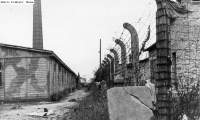 |
| HASAG Camp * |
The Jews lived in overcrowded barracks. Many died of starvation, the cruel treatment or from typhus. In December 1944 HASAG-Pelcery came under SS control and the conditions became worse, similar to those in a German concentration camp.
On 15-16 January 1945, because of the Soviet offensive, the SS evacuated the camp. Around 5,000 prisoners were sent to the concentration camps Buchenwald, Gross-Rosen and Ravensbrück where most of them perished.
 |
| After the Destruction * |
There had been a Jewish resistance group organised since the summer of 1942. First attempts at armed resistance were made during the liquidation of the Big Ghetto. The main headquarters of the ZOB was on Nadrzeczna Street 66, hence this group was called "Fighting Group 66". In June 1943 the leader of the group, Dr Adam Wolberg, was denounced to the Gestapo and killed. Between 23 and 26 June 1943 the SS surrounded the Small Ghetto. The resistance fighters did not know the exact date of this Aktion and were surrounded by a much greater number of police and SS. Those who were captured, were immediately deported to Treblinka. Finally the Germans destroyed the ghetto.
The man responsible for the deportations was SS-Hauptsturmführer Paul Degenhardt from Czestochowa Gestapo. He even killed personally and was described as perfect organiser. After the war he was sentenced to life imprisonment by a court in Lüneburg (Germany) because of the shooting of about 51 Jews.
Degenhardt replaced Hauptmann Heutz in spring 1942 as chief of the Czestochowa police. Between spring and summer 1942 the police command (later called Schupo-Kommando) was extended from 30 - 40 to 50 - 60 Germans. The headquarters were located at the Polish townhouse in 75 Marienallee Street. Degenhardt was also chief of around 240 Polish policemen and the Jewish order service (ghetto police). He was subordinate to the Orpo (order police) commander Radom and SS- und Polizeiführer in Radom, SS-Standartenführer Dr. Böttcher (death penalty in 1949 in Poland).
Böttcher, together with his adjutant Blum and Kriminalrat (detective councillor) Feucht, activated Aktion Reinhard in Czestochowa. Feucht, experienced in deportation actions, organized the "resettlement" trains and the police troops that assisted the Czestochowa police during the "actions". In the summer of 1942 Böttcher, Blum, Feucht and Degenhardt met in Czestochowa. Degenhardt produced a ghetto map and explained the important facts about the ghetto Jews. Böttcher appointed him leader of the "resettlement" actions, commanding all activities. Later Degenhardt called himself "father of the Jews". The Jews themselves regarded him as "the master of life and death".
Only around 5,000 Jews were still alive when the Red Army liberated Czestochowa on 17 January 1945, among them 1,500 Jews from Czestochowa itself.
Trials (partially in German)
Photos:
GFH *
Sources:
Encyclopedia of the Holocaust
Anna Bieszk's, Paulina Cisowska's, Marysia Krefta's and Dorota Lygas' website Getto Czestochowa
Dr Dick de Mildt, www.jur.uva.nl/junsv
Special thanks to Jarek Bykowski from Czestochowa
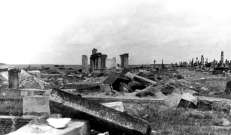
|
| Destroyed Cemetery * |
 |
| 50,000 Jews lived in the ghetto |
© ARC (http://www.deathcamps.org) 2005